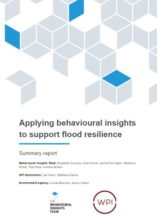Key findings
- How can you encourage homeowners to protect their homes from flooding 🌊? Our trial with @EnvAgency found that using reciprocity (highlighting that the gov needs ‘you’ to ‘do your bit too’) increases click-through by 22%! 🤝 Tweet
- BIT and @wpi_economics ran an RCT with @EnvAgency to see if asking homeowners to think about what it would be like to be flooded would improve engagement with flood plans ✍️.Homeowners rated our ‘future self’ flood plan as 14.8% more useful than the original one 🔮! Tweet
- ‘We’re protecting the country from flooding, but we need you to do your bit too.’ Did we grab your attention there by leveraging ~reciprocity~? If so, learn more: Tweet
Flooding the most significant natural disaster risk to UK homes, and climate change is increasing the risk of flooding even further. Homeowners can minimise the risk of flood damage by taking measures to protect their homes (also known as property flood resilience measures).
This report describes our work with the Environment Agency and WPI Economics to encourage homeowners to protect their homes. We ran three trials to test different approaches:
- Trial 1: Improving the Government’s ‘prepare for flooding’ webpage
- Trial 2: Increasing engagement with Environment Agency social media ads about flooding
- Trial 3: Improving personal flood plans hosted on the Environment Agency’s website.
We found that:
- None of our new ‘prepare for flooding’ webpages had any impact on our primary outcome measure (a measure of how confident people felt in their ability to protect their properties). However, we found that all of the webpages led to better outcomes than when participants saw no webpage at all. This indicates that viewing informational web pages delivers benefits to self-efficacy, response-efficacy, and awareness.
- Using a ‘reciprocity’ framing within social media ads increased click-though and video completion rates. This implies that highlighting the shared social contract between government and homeowners increases engagement with communications about flooding.
- All four of our improved flood plans lead to improvements across a range of outcome measures. Our ‘future self’ treatment (where participants were asked to consider what it would be like to be flooded) was most effective. Homeowners rated it as 14.8% more useful than EA’s current version. Our ‘context’ treatment (explaining the reason for flood plan’s suggestions) also performed strongly; homeowners rated it as 12.1% more useful than EA’s current version.









